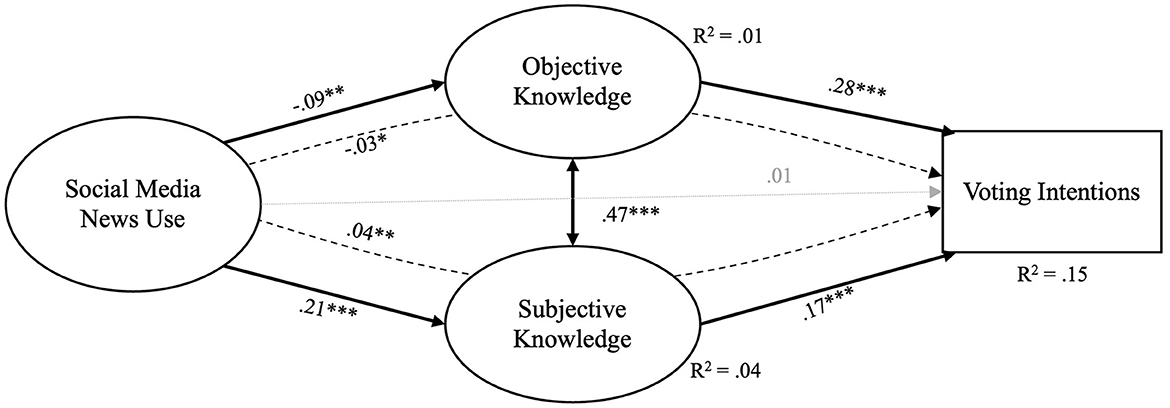- Department of Human-Centered Computing and Cognitive Science, University of Duisburg-Essen, Duisburg, Germany
A Corrigendum on
How incidental and intentional news exposure in social media relate to political knowledge and voting intentions
by Dreston, J. H., and Neubaum, G. (2023). Front. Psychol. 14:1250051. doi: 10.3389/fpsyg.2023.1250051
In the published article, there was an error in Figure 1. The figure consists of four boxes, whereby the middle boxes were incorrectly both labeled “Objective Knowledge”. The bottom middle box should be labeled “Subjective Knowledge” instead. The corrected Figure 1 and its caption appear below.

Figure 1. Model 1. Model fit: χ2(270) = 366.55, p < 0.001, χ2/df = 1.75, CFI = 0.98, RMSEA = 0.03 (90% CI: 0.02, 0.03), SRMR = 0.03; p < 0.05 (*), p < 0.01 (**), p < 0.001 (***); Full lines indicate significant direct associations, dashed lines indicate indirect significant associations, dotted lines indicate non-significant association.
The authors apologize for this error and state that this does not change the scientific conclusions of the article in any way. The original article has been updated.
Publisher's note
All claims expressed in this article are solely those of the authors and do not necessarily represent those of their affiliated organizations, or those of the publisher, the editors and the reviewers. Any product that may be evaluated in this article, or claim that may be made by its manufacturer, is not guaranteed or endorsed by the publisher.
Keywords: subjective knowledge, political knowledge, social media, election, incidental news exposure
Citation: Dreston JH and Neubaum G (2024) Corrigendum: How incidental and intentional news exposure in social media relate to political knowledge and voting intentions. Front. Psychol. 15:1476279. doi: 10.3389/fpsyg.2024.1476279
Received: 05 August 2024; Accepted: 19 August 2024;
Published: 30 August 2024.
Edited and reviewed by: Erin A. Vogel, University of Oklahoma Health Sciences Center, United States
Copyright © 2024 Dreston and Neubaum. This is an open-access article distributed under the terms of the Creative Commons Attribution License (CC BY). The use, distribution or reproduction in other forums is permitted, provided the original author(s) and the copyright owner(s) are credited and that the original publication in this journal is cited, in accordance with accepted academic practice. No use, distribution or reproduction is permitted which does not comply with these terms.
*Correspondence: Jana H. Dreston, amFuYS5kcmVzdG9uQHVuaS1kdWUuZGU=
 Jana H. Dreston
Jana H. Dreston German Neubaum
German Neubaum